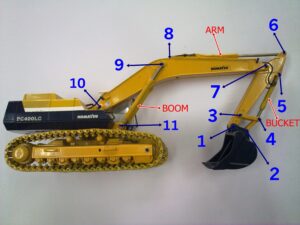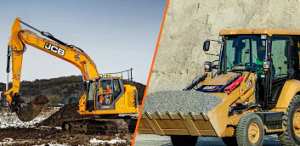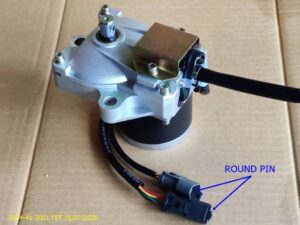I’ve seen the power of excavators up close as a construction worker. These machines are the quiet heroes of the industry. They efficiently change the landscape for us. From leveling ground for skyscrapers to cutting through tough terrain, excavators make the hard tasks easy.
This guide will dive into the world of excavators. We’ll cover their types, main parts, and how they’re used in construction, mining, and infrastructure projects in Malaysia. If you’re a contractor or a homeowner doing some landscaping, knowing what these machines can do will change the game.
Key Takeaways
- Excavators are the powerhouses of the construction industry, capable of tackling a wide range of earthmoving tasks.
- These machines come in various sizes and configurations, each designed for specific applications.
- Excavators play a crucial role in site preparation, demolition, mining, quarrying, infrastructure development, and land clearing.
- Proper maintenance and safety considerations are essential for maximizing the efficiency and longevity of excavators.
- Choosing the right excavator for your needs requires careful consideration of factors such as size, weight, and attachment options.
Understanding the Excavator: A Powerhouse of Construction
The excavator is a key tool in heavy construction. It’s versatile and essential for many tasks, from preparing sites to demolishing buildings and mining. Let’s explore the different excavator types and their applications. This will help us see how these machines shape our world.
Types and Applications of Excavators
Excavators vary in size and design for specific excavator applications. Compact ones fit in tight spots and are great for city jobs. Big ones are perfect for mining and quarrying. Tracked excavators handle tough terrain well, while wheeled ones move easily on roads.
Excavators can also have many attachments. These tools let them do various jobs, like demolition, clearing sites, and building roads. With the right attachments, excavators can do almost anything.
Key Components and Working Mechanisms
The boom, arm, and bucket of an excavator work together. They let the operator control the machine for precise digging. The undercarriage, with its tracks or wheels, keeps the machine stable and moves it around easily.
The excavator mechanics are also key. They use advanced hydraulics and computer controls for smooth and precise work. Knowing how these machines work helps professionals use them safely and efficiently.
The excavator is a true powerhouse in construction. It can handle many challenges with great efficiency and flexibility. From the various excavator types to their detailed components and mechanics, excavators are essential for construction projects.
Site Preparation: Where Excavators Shine
Excavators are key in site preparation, turning raw land into a place ready for building. They are great at clearing land, grading, and moving earth. This makes them essential for starting projects.
Excavators clear away trees, bushes, and other things that get in the way. They make the land smooth and even for building. Their strength is vital for site preparation, land clearing, and earth moving tasks.
- Excavators can make the ground flat and even, which is crucial for building things.
- They can dig, lift, and move a lot of dirt and rocks, which is important for getting the site ready.
- With special tools like buckets and breakers, excavators can handle many site preparation tasks.
| Site Preparation Task | Excavator Contribution |
|---|---|
| Land Clearing | Removing trees and other things to get the site ready for building. |
| Grading | Leveling the ground to make a solid base. |
| Earthmoving | Digging, moving, and placing dirt, rocks, and other materials to prepare the site. |
Using excavators, construction teams can quickly turn tough sites into places ready for building. This helps them finish their projects successfully.
“Excavators are the backbone of site preparation, seamlessly transitioning raw land into a canvas ready for development.”
Demolition and Excavation: The Excavator’s Core Strengths
Excavators are key in demolition and excavation, showing their strength and versatility. They are perfect for tearing down old buildings and making new foundations. These machines are essential for professionals in the construction world.
Demolition Techniques and Safety Considerations
Excavators are great at demolition, using their strong hydraulic arms and attachments. They can take down buildings safely and precisely. It’s important to focus on safety, with operators knowing how to do selective demolition and manage debris.
Excavation Methods and Best Practices
Excavators are also vital for excavation, from preparing sites to moving earth. They can dig, lift, and move a lot of soil and rock. Operators use different methods like trenching and grading to get the job done well and on time.
Following best practices helps teams work efficiently and with less trouble. This way, excavators can do their best work.
“Excavators are the backbone of any major demolition or excavation project, showcasing their power, precision, and adaptability in the toughest of construction challenges.”
Mining and Quarrying: Excavators in the Extraction Industry
In the world of mining and quarrying, excavators are key. They shape the landscape and help get valuable resources out. These machines are vital, doing many tasks with great efficiency and power.
Excavators are crucial in both open-pit mines and quarries. They handle tough jobs like removing overburden, loading materials, and managing stockpiles. This makes them essential in the mining and quarrying fields.
Excavators in Mining
In mining, excavators remove overburden, the soil and rock covering minerals. They work fast and efficiently to get to the minerals. They also load materials onto haul trucks, keeping production smooth.
Excavators in Quarrying
Quarrying needs excavators for extracting and loading materials like limestone, granite, and sand. These machines are key in managing quarry stockpiles. They make sure there’s a steady supply of materials for construction and other uses.
Excavators have changed mining and quarrying for the better. They’ve made these industries more productive, safer, and efficient. As the need for raw materials grows, excavators will keep playing a vital role.
Infrastructure Projects: Building the Future with Excavators
Excavators are key to building the future of communities in Malaysia. They are used in road construction, utility work, and big development projects. These machines are vital for changing the landscape and making progress possible.
Road Construction and Utility Work
Excavators lead the way in building new roads and keeping old ones up. They dig, move earth, and set up drainage and utilities underground. Their strength and control are crucial for making roads safe and efficient for everyone.
Excavators in Large-Scale Development
Excavators also play a big part in big projects that change neighborhoods and cities. They prepare sites, demolish old buildings, and dig foundations for new ones. This helps create the infrastructure needed for growing communities.
Excavators are essential in Malaysia for building important public and private spaces. They help shape the future of the nation by making the infrastructure needed for it.
Land Clearing and Forestry Operations
Excavators are key in land clearing and forestry work. They are essential for many tasks. From cutting down trees and grinding stumps to managing plants, these machines are vital for efficient projects.
Excavators are mainly used for land clearing. They come with special tools like shears. These tools help remove trees, bushes, and other plants. This is very useful when manual work or small machines can’t do the job.
In forestry operations, excavators are perfect for clearing paths, removing debris, and helping with tree cutting. They can go over tough ground and carry heavy stuff. This makes them crucial in the forestry world, where doing things fast and safely is important.
Excavators with special attachments like mulching heads or tree shears are great for forestry work. These tools let operators cut and clear plants carefully. This makes forestry work smooth and good for the environment.
| Application | Excavator Benefits |
|---|---|
| Land Clearing | Efficient removal of trees, shrubs, and vegetation; site preparation for development |
| Forestry Operations | Clearing access roads, managing debris, assisting with selective tree harvesting |
Whether you’re working on a land clearing project or doing forestry operations, excavators are a must-have. Their power and flexibility make them essential for these tasks.
Choosing the Right Excavator for Your Needs
Choosing the right excavator is key for construction projects. This guide helps you pick the best one by looking at excavator size, excavator weight, and excavator attachments and excavator customization options. This ensures you get an excavator that fits your project perfectly.
Size and Weight Considerations
The size and weight of the excavator matter a lot. Big excavators are great for big tasks like demolition and moving earth. Smaller ones fit in tight spots and are good for fine work. Think about your project’s size and what you need to do to pick the right excavator size and excavator weight.
Attachments and Customization Options
Excavators can have many attachments to make them better for your job. You can get buckets, hammers, grapples, and augers, among others. These excavator attachments can be changed to fit what you need. Plus, you can customize your excavator with things like different cab sizes or special features.
By thinking about these factors, you can find the best excavator for your project. This means you’ll work more efficiently, be safer, and save money.
“Choosing the right excavator is crucial for the success of any construction project. It’s not just about size and power, but also the ability to customize the machine to meet your specific needs.”
Excavator Maintenance and Safety
Keeping your excavator in top shape is key for its performance and lifespan. Regular checks and solving problems early are vital. This keeps your excavator efficient and reliable on the job.
Excavator Maintenance Essentials
There are several steps to keep your excavator running well:
- Check and change fluids like engine oil, hydraulic fluid, and coolant as needed
- Look for and replace worn or damaged parts, like filters, belts, and hoses
- Clean the machine’s outside and undercarriage to stop debris buildup
- Sharpen or replace the excavator’s bucket or attachments when necessary
By doing these tasks regularly, your excavator will work better and avoid expensive repairs.
Excavator Safety Protocols
Safe use of your excavator is just as important as maintenance. Important safety steps include:
- Training all operators well so they know the machine’s limits and how it works
- Doing detailed checks before starting work to spot any dangers
- Keeping a safe distance from power lines, buildings, and other obstacles
- Using the right signals and talking clearly with your team
Putting safety first helps protect your team and keeps your projects on track.
A well-kept and safely used excavator is crucial for success in construction or earthmoving. By sticking to these guidelines, your excavator will stay a trusted and effective part of your equipment.
Conclusion
Excavators are key in Malaysia’s construction, mining, and infrastructure sectors. They help with site prep, demolition, earthmoving, and resource extraction. Knowing the types of excavators and their uses helps construction pros use these machines well for tough projects.
Excavators are vital for road building, mining, or big land projects. The right one boosts productivity, safety, and saves money. By picking the right size and attachments, you get the most out of your excavator.
The need for reliable construction gear is growing in Malaysia. Excavators are becoming more important. Staying updated with new tech and maintenance tips helps your business succeed. This way, you lead in offering earthmoving solutions that help progress and growth in the country.
FAQ
What are the main types of excavators and their applications?
Excavators come in different types, each for specific tasks. Common types include: – Crawler excavators: Great for site prep, demolition, and moving earth – Wheeled excavators: Perfect for paved surfaces, utility projects, and road work – Mini excavators: Ideal for small spaces and urban projects because they’re compact and easy to move – Dragline excavators: Mainly used in mining and quarrying for removing overburden and extracting materials
What are the key components of an excavator?
An excavator’s main parts are: – Boom: This arm-like piece gives the lifting and digging power – Arm: Connects the bucket to the boom and can move – Bucket: At the end of the arm, it’s used for digging, loading, and handling materials – Undercarriage: The tracked or wheeled base that keeps the excavator stable and moves it around – Cab: Where the operator sits, controlling the machine and seeing what’s happening
How are excavators used for site preparation and land clearing?
Excavators are key for getting sites ready and clearing land by: – Cutting down trees, removing stumps, and clearing vegetation – Leveling and smoothing the ground to make it even and stable – Digging up soil and rock to clear the site for building – Moving materials to and from the site
What are the key considerations for demolition and excavation work using excavators?
For demolition and excavation, remember: – Safety first, with trained operators – Use controlled demolition and precise excavation – Handle dangerous materials and debris carefully – Keep projects on schedule and minimize disruptions
How do excavators contribute to mining and quarrying operations?
In mining and quarrying, excavators are vital for: – Removing overburden to get to minerals – Loading and moving materials – Managing stockpiles and handling materials – Helping build access roads and infrastructure
What are some of the key infrastructure projects that utilize excavators?
Excavators are crucial for many infrastructure projects, like: – Building and maintaining roads – Installing and fixing utilities (water, sewer, electricity, telecom) – Preparing sites for big projects – Digging and moving earth for bridges, highways, and railways
How can I choose the right excavator for my specific needs?
When picking an excavator, think about: – The size and weight you need for your project – The attachments and custom options you require – How fuel-efficient and eco-friendly it is – Maintenance and support services in your area
What are the key maintenance and safety considerations for excavators?
Keeping excavators safe and well-maintained is key, by: – Checking and servicing important parts regularly – Training operators and making sure they’re certified – Following safety rules and wearing protective gear – Fixing problems early to avoid downtime



